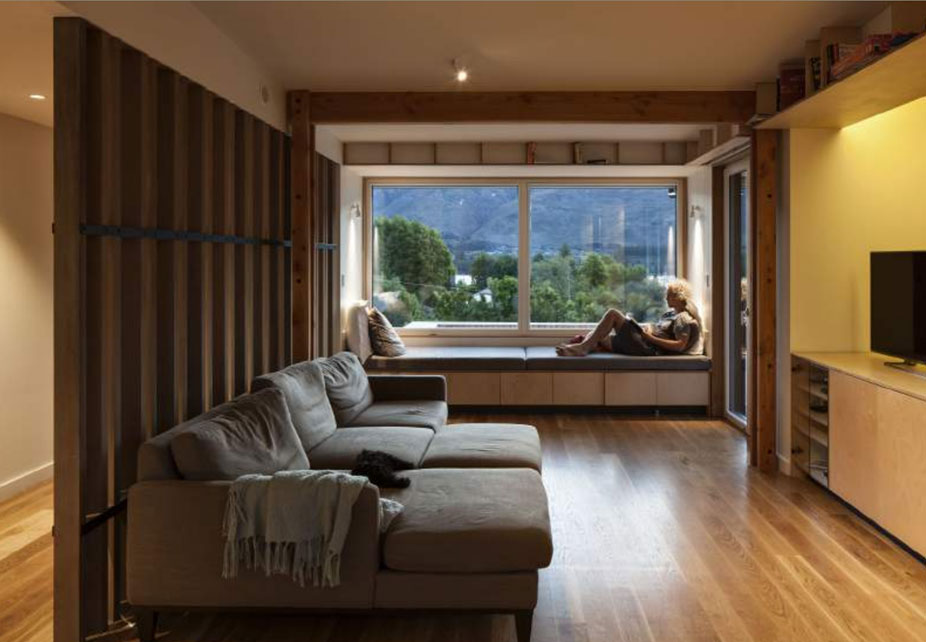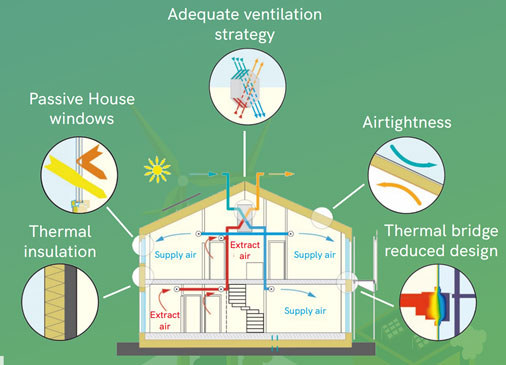|
Passive home in Wanaka, photo by Simon Devitt – PHINZ brochure 2017 Sustainability and energy efficiency have largely driven the conversation surrounding passive homes in New Zealand, and for good reason. Certainly, passive house are not just worth the investment, but also vital to New Zealand’s goal of net-zero carbon emissions by 2050. However, the benefits of passive homes don’t stop at helping to beat climate change. They also offer significant benefits to your personal wellbeing! With a passive house, you don’t have to sacrifice your comfort to further the cause of sustainability. That’s because passive homes achieve high levels of operational efficiency as well as offering you an exceptional level of comfort and a healthy living environment. Building using the Passive House standard means that you can choose health and comfort whilst maintaining world leading quality. Learn more about these personal benefits below. What is the Passive House Standard and how can it benefit you? Passive House is a building design and quality assurance standard that maximises the energy efficiency of a home. Passive Houses are designed to meet strict standards of airtightness, insulation, and indoor air quality, amongst other things. Importantly, a Passive House is modelled prior to construction on how well a house operates within its unique circumstances, such as the climate and orientation. That’s why a passive house in the South Island might require triple-glazed windows while a passive house in Northland may need only double-glazing to achieve the same standard. The 5 principles of Passive House – PHINZ brochure 2017 A Passive House will deliver superior air quality and excellent acoustic, thermal, and visual comfort. The high level of indoor air quality is provided in part by the continuous mechanical ventilation system, which continuously circulates fresh, filtered air. This is particularly noticeable for those suffering from asthma or hay fever. You will find a Passive house is noticeably quiet inside, giving a palpable sense of calm. You will also notice the comfortable temperature, regardless of external conditions, and that this temperature is maintained throughout the house. This means no cold spots or the need to close doors to keep the heat in certain parts of the house.
Passive houses achieve these outcomes by taking a fabric-first approach that focuses on the building envelope (floors, walls, and roof) at the design stage, as these are ultimately the elements that will have the biggest impact when it comes to making your home more energy-efficient and comfortable. A home that prevents condensation, draughts, and mould, dampens exterior noise, and maintains a stable and comfortable temperature, will meet many of the goals of a Passive House. You might notice that the word “comfort” appears frequently here, and that’s no accident. One aspect of Passive Houses that is often overlooked is that an inefficient home is often also uncomfortable! The same problems that cause a home to waste energy also cause that home to be draughty and even mouldy. By maximising operational efficiency, Passive Houses deliver peak temperature control and air quality, providing meaningful benefits to you. Comfort Passive Houses are designed to maintain a temperature between 20° and 22°C without heating or cooling and maintain an even temperature throughout the house, thanks to a superior building envelope. Health We spend, on average, over 80% of our time indoors, so quality ventilation can have a major impact on our physical health. Mechanical ventilation—an important element in passive homes—filters out dust, pollen, and other airborne contaminants to keep your home fresh and clean. Thermal recovery systems ensure that heat is not lost or gained. Furthermore, levels of humidity are kept under a certain amount (often under 40%) to minimise the risk of mould, which in turn contributes to higher indoor air quality. Resilience Structurally, passive houses are built to exceed—not merely meet—the New Zealand Building Code durability and resilience requirements. Superior airtightness and insulation are defining features in a passive house. An exterior weathertight layer and internal membrane or airtightness layer keeps external and internal moisture out of the insulation layers of the thermal envelope. Savings The cost of living in a passive house is one of the questions we are most frequently asked about at Craft Homes. A Passive House can cost the same to build as an architecturally designed house. However, it is vital that high-performance, Passive House features are specified from the start. The most important thing with a Passive House is to prioritise the building envelope and the primary Passive House design elements when budgeting for your new build. If you find that you don’t have the budget upfront for a fancy kitchen or lavish bathroom, then that might be an opportunity for a renovation further down the road. The exceptional operational efficiency of a Passive House will make budgeting for future renovations and additions easier. You can also preserve your budget by keeping your design simple. A rectangular home, for example, is much easier than complex shapes, in part because simple, square designs lose less heat. When accounting for the true savings a passive house can provide, it’s important to keep the following elements in mind:
Craft Homes are Bringing These Benefits to New Zealand Homeowners The certified and qualified team of Passive House builders at Craft Homes has been among New Zealand’s most passionate advocates for sustainable homes. Our exciting new build in Raglan will be an opportunity to share the many benefits of passive home living with New Zealand. Contact Craft Homes today to learn more about how passive homes can improve your overall wellbeing and save you money.
2 Comments
Juie
12/12/2023 08:47:50 pm
I appreciate the emphasis on the importance of continuous learning and acquiring new skills to stay relevant in the money-making landscape. It's a valuable mindset for growth. For additional insights, <a href="https://singingfiles.com/show.php?l=0&u=1810055&id=54864" target="_blank">click here</a>.
Reply
Leave a Reply. |
AuthorToby and Cat Tilsley Archives
September 2021
Categories |



 RSS Feed
RSS Feed


